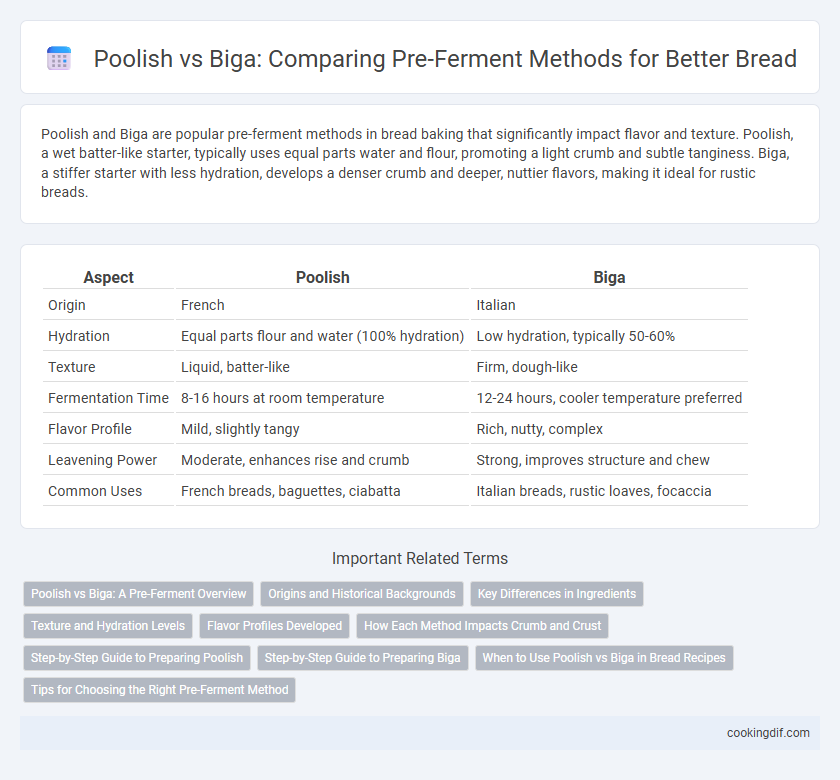Poolish and Biga are popular pre-ferment methods in bread baking that significantly impact flavor and texture. Poolish, a wet batter-like starter, typically uses equal parts water and flour, promoting a light crumb and subtle tanginess. Biga, a stiffer starter with less hydration, develops a denser crumb and deeper, nuttier flavors, making it ideal for rustic breads.
Table of Comparison
| Aspect | Poolish | Biga |
|---|---|---|
| Origin | French | Italian |
| Hydration | Equal parts flour and water (100% hydration) | Low hydration, typically 50-60% |
| Texture | Liquid, batter-like | Firm, dough-like |
| Fermentation Time | 8-16 hours at room temperature | 12-24 hours, cooler temperature preferred |
| Flavor Profile | Mild, slightly tangy | Rich, nutty, complex |
| Leavening Power | Moderate, enhances rise and crumb | Strong, improves structure and chew |
| Common Uses | French breads, baguettes, ciabatta | Italian breads, rustic loaves, focaccia |
Poolish vs Biga: A Pre-Ferment Overview
Poolish is a thin, batter-like pre-ferment with equal parts water and flour, typically fermented for 12-16 hours, enhancing dough extensibility and producing a mild, aromatic flavor. Biga is a stiffer Italian pre-ferment with lower hydration, fermented for 16-24 hours, contributing to a denser crumb, more complex flavor, and improved structure in bread. Both methods improve fermentation, but Poolish yields a softer texture while Biga offers more chew and a robust crumb.
Origins and Historical Backgrounds
Poolish originated in Poland during the 19th century and was introduced to French bakers, influencing traditional French bread-making techniques. Biga has its roots in Italy, with a long history in Italian artisan baking, especially for producing rustic breads like ciabatta. Both pre-ferments were developed to enhance dough flavor and texture by extending fermentation times, reflecting regional baking traditions.
Key Differences in Ingredients
Poolish is a wet pre-ferment made with equal parts flour and water, creating a batter-like consistency, while biga is a stiff pre-ferment with lower hydration, resulting in a doughier texture. Poolish typically uses equal ratios of flour and water with a small amount of yeast, enhancing gluten development and flavor, whereas biga employs less water and more yeast, producing a firmer structure and a more pronounced fermentation aroma. These ingredient variations affect dough extensibility, rise time, and the final bread's crumb and crust characteristics.
Texture and Hydration Levels
Poolish offers a higher hydration level, usually around 100%, producing a wetter dough that results in a lighter, airier crumb with open holes. Biga typically has lower hydration, about 50-60%, creating a stiffer dough that yields a denser texture with a more uniform crumb structure. The choice between Poolish and Biga depends on desired bread texture, with Poolish enhancing softness and openness, while Biga promotes strength and a chewy crust.
Flavor Profiles Developed
Poolish imparts a mild, slightly tangy flavor with complex yeast aromas due to its high hydration and balanced fermentation time. Biga offers a nuttier, more robust taste with enhanced acidity and firmer crumb structure resulting from its lower hydration and longer fermentation. Both pre-ferments enrich bread flavor by promoting enzymatic activity and organic acid production that deepen overall taste complexity.
How Each Method Impacts Crumb and Crust
Poolish pre-ferment enhances bread crumb by creating a moist, open texture with irregular holes and a mild tangy flavor, while producing a thin, crisp crust due to its high hydration level. Biga, with lower hydration, contributes to a tighter, denser crumb and a thicker, chewier crust, resulting in a heartier bread structure. Both methods improve gluten development and flavor complexity but distinctly influence crumb porosity and crust texture.
Step-by-Step Guide to Preparing Poolish
To prepare Poolish, mix equal parts water and flour by weight with a small amount of yeast, typically 0.1% to 0.2% of the flour weight. Stir the mixture until smooth, cover it with plastic wrap, and let it ferment at room temperature for 12 to 16 hours until it becomes bubbly and doubles in volume. This pre-ferment enhances bread flavor and texture by allowing natural fermentation before mixing the final dough.
Step-by-Step Guide to Preparing Biga
Biga, an Italian pre-ferment, involves mixing flour, water, and a small amount of yeast to create a stiff dough that ferments slowly at room temperature for 12 to 16 hours. This process enhances the bread's flavor and texture by promoting gluten development and natural yeast activity before incorporating it into the final dough. Precise hydration levels between 50-60% and fermentation time are critical for achieving optimal crumb structure and a complex, slightly tangy taste.
When to Use Poolish vs Biga in Bread Recipes
Poolish is ideal for bread recipes requiring a light, open crumb and a slightly tangy flavor, such as baguettes and other French-style breads, due to its high hydration and shorter fermentation time. Biga, with lower hydration and longer fermentation, suits Italian breads like ciabatta, providing a firmer texture and nuttier, more complex flavor profile. Selecting poolish or biga depends on desired crumb structure, flavor intensity, and dough handling properties in specific bread recipes.
Tips for Choosing the Right Pre-Ferment Method
Selecting the right pre-ferment method depends on the desired flavor profile and fermentation time, with poolish offering a thinner consistency and a slightly tangy taste, ideal for open crumb breads. Biga, a stiffer pre-ferment from Italian baking, enhances dough strength and provides a nutty, complex flavor suited for rustic loaves. Bakers should consider hydration levels, fermentation duration, and the type of bread to achieve optimal texture and taste when choosing between poolish and biga.
Poolish vs Biga for pre-ferment methods Infographic

 cookingdif.com
cookingdif.com